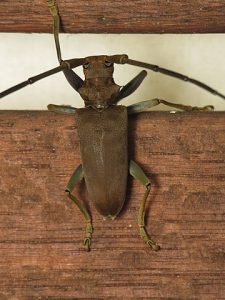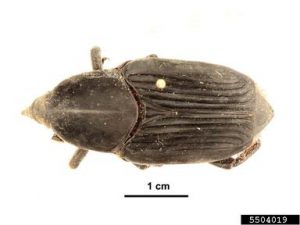California Pest Rating for
Hypothenemus eruditus Westwood
Coleoptera: Curculionidae: Scolytinae
Pest Rating: B
PEST RATING PROFILE
Initiating Event:
Hypothenemus eruditus is currently Q-rated. A permanent pest rating proposal is required to support an official pest rating.
History & Status:
Background: This tiny (1-1.2 mm in length) bark beetle is one of the most widely-distributed and variable species in the genus Hypothenemus (Bright and Stark, 1973). The beetle has been reported to feed on hundreds of species of plants and other materials as well, including fungus and even the cover of a book (evidently the reason for the choice of the name eruditus) (Huang, 2016; Turner and Beaver, 2015; Wood, 1982). In plants, it is reported to feed in dying twigs and branches (Bright and Stark, 1973). Females mate with their flightless male siblings before leaving the gallery. Hypothenemus eruditus does not appear to cause any recognized economic or environmental impact (Huang, 2016; Turner and Beaver, 2015). Recent work suggest that there may be multiple (>10) cryptic species that are currently identified as Hypothenemus eruditus; this is perhaps not surprising, given the many synonyms listed for it, its minute size, and its morphological variability (Huang, 2016; Kirkendall and Jordal, 2006).
Worldwide Distribution: Hypothenemus eruditus is widely distributed. The species occurs in Europe, Asia, Africa, Australia, North America, Central America, and South America. In the United States, it occurs in the eastern United States and in California (Bright and Stark, 1973; Wood, 1982.
Official Control: Hypothenemus eruditus is not known to be under any official control.
California Distribution: Hypothenemus eruditus has been reported from Los Angeles, Orange, San Diego, and Santa Barbara counties. Records representing collections exclusive of nurseries were found for the following localities: Santa Barbara County: Arroyo Hondo Preserve (2002); Santa Rosa Island, Cherry Canyon, Torrey pines grove, and Windmill Canyon (2008); San Diego County: Santee (2012) (PDR# 1316740) (Bright and Stark, 1973; CDFA Pest and Damage Record; Symbiota Collections of Arthropods Network).
California Interceptions: Hypothenemus eruditus has been intercepted twice on shipments entering California: Once on dried twigs from Laos (PDR# 050455) and once on Polyscias fruticosa from Florida (PDR# 063283). As mentioned above, this beetle was also found on avocado in a residential garden in Santee, San Diego County, California (PDR# 1316740).
The risk Hypothenemus eruditus would pose to California is evaluated below.
Consequences of Introduction:
1) Climate/Host Interaction: Hypothenemus eruditus occurs widely in the United States. The species occurs in California and on the east coast, from New Hampshire to Florida and west to Illinois and Texas. This suggests that eruditus could become established over a significant portion of California. The list of hosts includes hundreds of species of plants and fungi. Therefore, it receives a High (3) in this category.
– Low (1) Not likely to establish in California; or likely to establish in very limited areas.
– Medium (2) may be able to establish in a larger but limited part of California.
– High (3) likely to establish a widespread distribution in California.
2) Known Pest Host Range: Hypothenemus eruditus is known to feed on hundreds of species of plants, as well as fungi. Therefore, it receives a High (3) in this category.
– Low (1) has a very limited host range.
– Medium (2) has a moderate host range.
– High (3) has a wide host range.
3) Pest Dispersal Potential: Hypothenemus eruditus is capable of sustained flight. Females mate with their flightless male siblings, so they leave their development site ready to colonize new host material (Huang, 2016). The beetle can also be transported in wood and wood products. Therefore, it receives a High (3) in this category.
– Low (1) does not have high reproductive or dispersal potential.
– Medium (2) has either high reproductive or dispersal potential.
– High (3) has both high reproduction and dispersal potential.
4) Economic Impact: Hypothenemus eruditus is not known to be an economically-significant pest (Huang, 2016). The species already occurs in California and the eastern United States and it has a widespread world distribution. However, no reports have been found suggesting that it has an economic impact. However, there is the possibility that other species, including cryptic ones, could be identified at eruditus. Such species could pose a threat to California agriculture, for example, lowering crop yield and increasing crop production costs. Therefore, it receives a Medium (2) in this category.
Economic Impact: A, B
A. The pest could lower crop yield.
B. The pest could lower crop value (includes increasing crop production costs).
C. The pest could trigger the loss of markets (includes quarantines).
D. The pest could negatively change normal cultural practices.
E. The pest can vector, or is vectored, by another pestiferous organism.
F. The organism is injurious or poisonous to agriculturally important animals.
G. The organism can interfere with the delivery or supply of water for agricultural uses.
Economic Impact Score: Medium (2)
– Low (1) causes 0 or 1 of these impacts.
– Medium (2) causes 2 of these impacts.
– High (3) causes 3 or more of these impacts.
5) Environmental Impact: Hypothenemus eruditus is not known to have an environmental impact anywhere. The beetle already occurs in California and the eastern United States and no reports were found of it having an environmental impact. However, this could reflect a lack of research rather than a lack of impact. In addition, there is the possibility that other species of Hypothenemus, including cryptic ones, could be identified at eruditus. Such species could pose a threat to the environment, for example, by disrupting natural communities. Therefore, it receives a Medium (2) in this category.
Evaluate the environmental impact of the pest on California using the criteria below.
Environmental Impact: A
A. The pest could have a significant environmental impact such as lowering biodiversity, disrupting natural communities, or changing ecosystem processes.
B. The pest could directly affect threatened or endangered species.
C. The pest could impact threatened or endangered species by disrupting critical habitats.
D. The pest could trigger additional official or private treatment programs.
E. The pest significantly impacts cultural practices, home/urban gardening or ornamental plantings.
Environmental Impact Score: Medium (2)
– Low (1) causes none of the above to occur.
– Medium (2) causes one of the above to occur.
– High (3) causes two or more of the above to occur.
Consequences of Introduction to California for Hypothenemus eruditus: High (13)
Add up the total score and include it here.
–Low = 5-8 points
–Medium = 9-12 points
–High = 13-15 points
6) Post Entry Distribution and Survey Information: Although this species is likely present in additional areas of California, Hypothenemus eruditus has been reported from outdoor, non-nursery localities in Santa Barbara and San Diego Counties. It receives a Low (-1) in this category.
–Not established (0) Pest never detected in California, or known only from incursions.
–Low (-1) Pest has a localized distribution in California, or is established in one suitable climate/host area (region).
–Medium (-2) Pest is widespread in California but not fully established in the endangered area, or pest established in two contiguous suitable climate/host areas.
–High (-3) Pest has fully established in the endangered area, or pest is reported in more than two contiguous or non-contiguous suitable climate/host areas.
Final Score:
7) The final score is the consequences of introduction score minus the post entry distribution and survey information score: Medium (12)
Uncertainty:
The most significant uncertainty regarding Hypothenemus eruditus is the species identity itself. There is evidence that there are actually multiple (>10) species that are currently recognized as H. eruditus. There is a risk that a species with biological characteristics differing from those considered for H. eruditus could be intercepted and not be regulated because it is identified as that species. Such a cryptic species could have greater (than is recognized for H. eruditus) potential for economic and/or environmental impact. Systematic research on Hypothenemus is needed. There is also a significant likelihood that H. eruditus is more widespread in California than is currently known. It is a tiny beetle and is not easy to identify.
Conclusion and Rating Justification:
Hypothenemus eruditus is widely distributed and is not known to have any economic or environmental impacts. However, there is evidence that multiple cryptic species of Hypothenemus may be currently identified as H. eruditus. A cautious approach has been taken and a “B” rating is justified.
References:
Bright Jr., D.E. and R.W. Stark. 1973. The Bark and Ambrosia Beetles of California. University of California Press. 169 pp.
Huang, Y.T. 2016. Featured creatures: Hypothenemus eruditus Westwood. University of Florida. http://entnemdept.ufl.edu/creatures/trees/beetles/Hypothenemus_eruditus.htm
Kirkendall, L. R. and B.H. Jordal. 2006. The bark and ambrosia beetles (Curculionidae, Scolytinae) of Cocos Island, Costa Rica and the role of mating systems in island zoogeography. Biological Journal of the Linnean Society. 89: 729-743.
Symbiota Collections of Arthropods Network. Accessed 5 February 2018. http://scan1.acis.ufl.edu
Turner, C.R. and R.A. Beaver. 2015. Hypothenemus eruditus Westwood and Hypothenemus seriatus (Eichhoff) (Curculionidae: Scolytinae: Cryphalini) in Britain. The Coleopterist. 24(1): 12-15.
Wood, S.L. 1982. The bark and ambrosia beetles of North and Central America (Coleoptera: Scolytidae), a taxonomic monograph. Great Basin Naturalist Memoirs. 6: 1-1356.
Author:
Kyle Beucke, 1220 N Street, Room 221, Sacramento, CA, 95814, 916-403-6741; plant.health[@]cdfa.ca.gov.
Responsible Party:
Jason Leathers, 2800 Gateway Oaks, Sacramento CA 95833, (916) 654-1211, plant.health[@]cdfa.ca.gov
Comment Period:* CLOSED
4/25/18 – 6/9/18
*NOTE:
You must be registered and logged in to post a comment. If you have registered and have not received the registration confirmation, please contact us at plant.health[@]cdfa.ca.gov.
Comment Format:
♦ Comments should refer to the appropriate California Pest Rating Proposal Form subsection(s) being commented on, as shown below.
Example Comment:
Consequences of Introduction: 1. Climate/Host Interaction: [Your comment that relates to “Climate/Host Interaction” here.]
♦ Posted comments will not be able to be viewed immediately.
♦ Comments may not be posted if they:
Contain inappropriate language which is not germane to the pest rating proposal;
Contains defamatory, false, inaccurate, abusive, obscene, pornographic, sexually oriented, threatening, racially offensive, discriminatory or illegal material;
Violates agency regulations prohibiting sexual harassment or other forms of discrimination;
Violates agency regulations prohibiting workplace violence, including threats.
♦ Comments may be edited prior to posting to ensure they are entirely germane.
♦ Posted comments shall be those which have been approved in content and posted to the website to be viewed, not just submitted.
Pest Rating: B
Posted by ls


